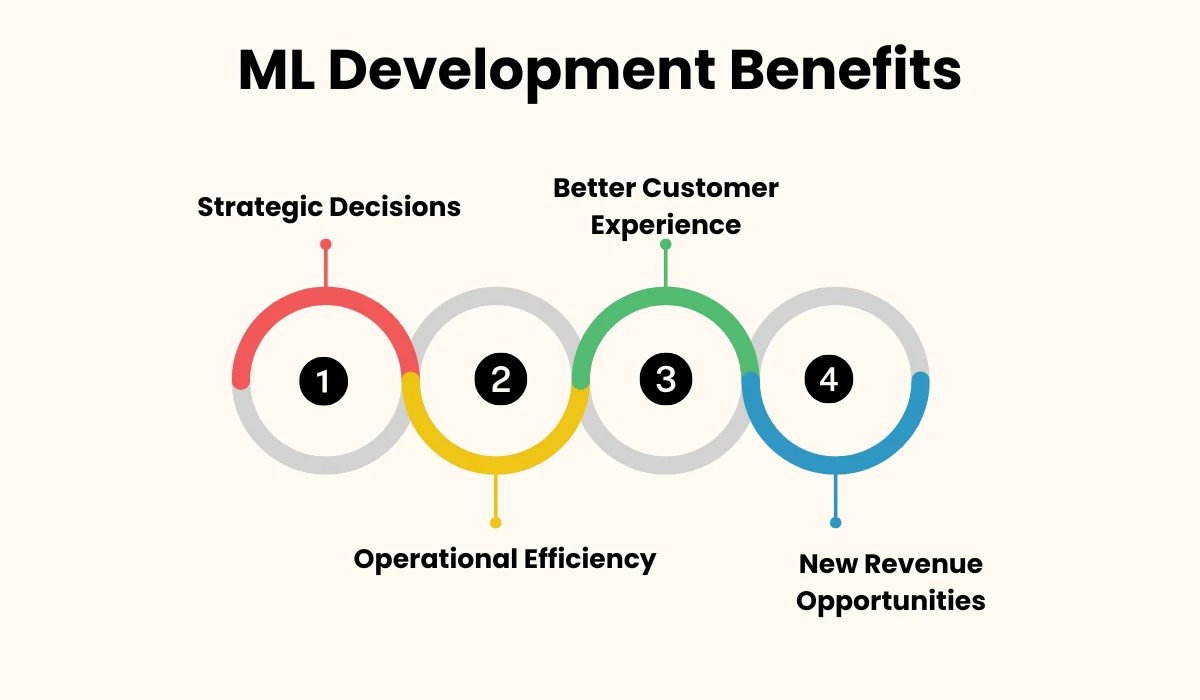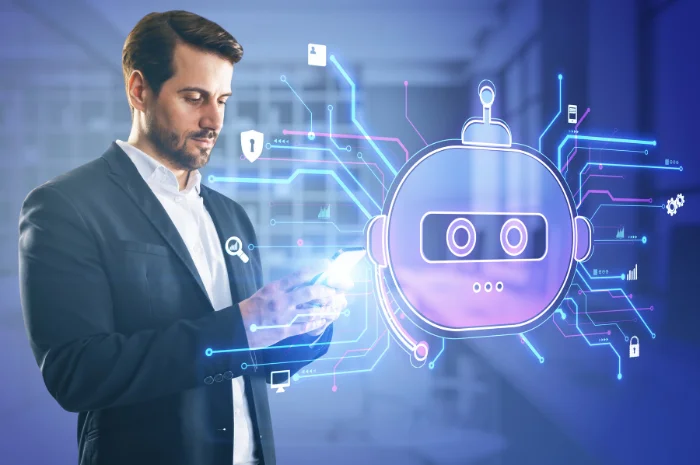Not long ago, adding machine learning (ML) to an app felt experimental. A few tech giants were doing it, while most companies stuck to rule-based logic. That’s no longer the case.
Today, ML is woven into everything from streaming platforms and e-commerce stores to healthcare systems and logistics apps. Businesses are using it to personalize user experiences, make faster decisions, and automate tasks that used to take entire teams.
What’s changed is the accessibility of ML development services. Cloud platforms, open-source frameworks, and better tooling have made it possible for teams to build and deploy ML-powered apps without starting from scratch. For businesses, that means developing machine learning applications is a practical way to build smarter, more competitive products.
Before diving into ML use cases in business, let’s get clear on what ML app development actually involves and how it differs from traditional app development.
What Is Machine Learning App Development? (And How It’s Different from Regular App Dev)
Traditional apps follow fixed rules. You define inputs, write logic, and get predictable outputs. If a customer spends more than $500, give them a 10% discount. Simple.
Machine learning applications work differently. Instead of hard-coding rules, you train models on data so the system can recognize patterns, make predictions, or personalize experiences automatically. Over time, the model improves as it learns from new data, something static logic can’t do.
Here’s how ML app development stands apart:
- Data at the core: Development starts with collecting, cleaning, and structuring data, not just writing code.
- Continuous learning: Models need monitoring, retraining, and tuning after launch. It’s not a one-and-done build.
- Integration with AI infrastructure: ML apps depend on pipelines, APIs, and sometimes edge devices to deliver predictions in real time.
- Cross-functional work: Data scientists, ML engineers, and app developers collaborate closely, rather than working in silos.
In short, whether you built-in or hire ML app development services, it is about building living systems that adapt and get smarter with use, which is exactly why it’s gaining traction across industries.
Also Read: 7 Stages of Machine Learning Development
Examples of Machine Learning Apps Across Industries

Machine learning isn’t limited to one industry or one type of application. Once you understand its building blocks, the same techniques show up in very different contexts: retail, finance, healthcare, logistics, and beyond. Here are some of the most common examples of machine learning applications.
1. Personalization and Recommendation Engines
One of the earliest and most impactful uses of machine learning is personalization. Recommendation systems drive what you watch, buy, or read online.
- Streaming platforms suggest what to watch next based on your viewing history and the behavior of similar users.
- E-commerce apps reorder products on your homepage based on your preferences, purchase history, and browsing patterns.
- Learning platforms adapt lessons to your pace and skill level, recommending exercises that target your weak spots.
Under the hood, these systems use models like collaborative filtering (finding similar users) or content-based filtering (analyzing product or content attributes).
The business impact is clear: personalization keeps users engaged, increases average order value, and improves retention. It’s why even mid-sized apps now integrate some form of recommendation logic.
2. Predictive Analytics and Forecasting
Prediction is where ML shines. Instead of reacting to events after they happen, companies use ML models to anticipate future trends, giving them a strategic edge.
Some practical examples of machine learning apps in ecommerce are:
- Retail: Demand forecasting models help plan inventory and avoid overstocking or stockouts.
- Finance: Predictive models estimate credit risk or forecast market movements.
- Manufacturing: Predictive maintenance detects early signs of equipment failure, reducing downtime.
- Healthcare: Models predict disease risk based on patient history and population-level data.
These models pick up subtle patterns humans can’t catch at scale. The result is faster, more accurate decisions, often with measurable cost savings.
3. Natural Language Processing (NLP) Applications
Apps increasingly need to understand and interact with human language, and NLP makes that possible. A few common scenarios:
- Chatbots and virtual assistants handle routine customer queries 24/7, trained on real conversations and FAQs.
- Sentiment analysis helps brands track how customers feel across social media, reviews, and support tickets.
- Text classification automates tasks like sorting emails, tagging documents, or extracting specific clauses from legal contracts.
- Large language models (LLMs) have accelerated this space. Businesses can now integrate pre-trained models and fine-tune them for domain-specific tasks without building NLP engines from scratch.
4. Computer Vision
Computer vision models let apps interpret and act on visual data from images or videos. Once confined to research labs, these capabilities now run on mobile devices, cameras, and cloud infrastructure.
Typical applications of computer vision include:
- Retail: Visual search lets users upload a photo to find similar products instantly.
- Healthcare: AI models assist radiologists by flagging potential anomalies in scans.
- Manufacturing: Automated quality inspection catches defects on assembly lines in real time.
- Security: Surveillance systems detect unusual activity or identify faces.
Many of these models run at the edge (e.g., on devices) for real-time response, while more complex processing happens in the cloud. The result: faster insights with less human intervention.
5. Fraud Detection and Anomaly Detection
Fraud detection is a natural fit for ML. Rule-based systems can catch known fraud patterns, but they struggle with new, evolving tactics. ML models can flag unusual behavior by learning from massive volumes of transactional data.
Examples:
- Fintech and banking industry is taking machine learning app development services to build systems that can detect fraudulent transactions by spotting deviations from a user’s normal behavior.
- E-commerce platforms flag suspicious orders or refund patterns automatically.
- Cybersecurity tools use anomaly detection to identify unusual network traffic that could indicate a breach.
These models often run in real time, adding a critical layer of protection without slowing legitimate transactions.
6. Process Automation and Intelligent Workflows
Machine learning doesn’t replace traditional automation, it makes it smarter. By pairing ML with robotic process automation (RPA), companies handle complex, variable tasks that rules alone can’t manage.
Some examples:
- Invoice processing that uses ML to extract key fields from different formats and auto-validate them.
- Claims assessment in insurance that classifies and prioritizes cases based on complexity.
- Document verification using OCR and ML models to catch errors or fraudulent entries.
This kind of automation reduces manual effort, cuts turnaround time, and improves accuracy across back-office functions.
Other Emerging and Niche Use Cases of ML
Not every ML use case fits neatly into the categories above. A few growing areas include:
- Generative ML for product design, personalized marketing content, and rapid prototyping.
- Energy optimization in smart buildings, using ML to predict demand and adjust consumption dynamically.
- Dynamic pricing in travel and hospitality apps, adjusting rates based on real-time demand and competition.
These use cases may start as a niche, but many evolve into core business functions as adoption grows.
Machine learning’s strength is its flexibility. The same underlying techniques can power a recommendation engine, a fraud detection system, or a diagnostic tool. What matters is matching the right use case to your data, infrastructure, and business goals.
Also Read: How Machine Learning is Powering Smarter AI Agents
Benefits of ML App Development for Businesses

When done right, machine learning can transform how businesses operate and compete. The real value shows up in faster decisions, better customer experiences, and measurable efficiency gains.
Here are the core benefits businesses get from integrating machine learning:
1. Smarter, Faster Decisions
ML models can sift through millions of data points in seconds, spotting patterns humans would miss. That means teams can make decisions based on evidence, not guesswork. Whether it’s predicting demand, catching fraud early, or personalizing offers, ML gives businesses a sharper sense of what’s coming next.
2. Operational Efficiency
Tasks that once took hours or required manual oversight can now run automatically. For example:
- ML-powered document processing eliminates tedious data entry.
- Predictive maintenance cuts unexpected equipment downtime.
- Automated workflows keep processes moving without constant human checks.
This frees up people to focus on higher-value work while the app handles repetitive or time-sensitive tasks.
3. Better Customer Experiences
Personalization, natural language interactions, and intelligent recommendations make apps feel more intuitive. Users don’t have to dig to find what they want, the app adapts to them. The result is higher engagement, stronger retention, and more satisfied customers.
4. New Revenue Opportunities
ML can unlock entirely new business models:
- Dynamic pricing strategies that respond to real-time demand.
- Subscription models built around personalized experiences.
- Add-on ML-powered features (like advanced analytics) that customers are willing to pay for.
Businesses that move early often find themselves setting the market standard, not following it.
5. Competitive Advantage
When your app can learn and adapt faster than competitors’, that advantage compounds. The insights you gather, the optimizations you make, and the experiences you deliver build a moat that’s hard to replicate through manual effort or static code.
When (and When Not) to Use Machine Learning in Your App
Machine learning can be transformative, but it isn’t the right solution for every problem. Knowing when to apply it and when to stick with simpler approaches is key to success.
When to Use ML in Business
- You have sufficient data: More data usually means better predictions. Sparse or inconsistent data will limit ML’s effectiveness.
- Patterns are complex or hidden: Tasks like demand forecasting, fraud detection, or personalization benefit from models that can detect subtle correlations.
- You need adaptive solutions: If the environment changes frequently (user behavior, market conditions, equipment wear), ML can learn and adjust automatically.
- Automation isn’t straightforward: Repetitive tasks with lots of exceptions, like document review or claims processing, are ideal for ML-powered workflows.
The key is that ML solves problems that are too complex, too variable, or too time-consuming for traditional rule-based systems.
When Not to Use ML
- You have a small or low-quality dataset: A simple rule-based solution will often outperform an undertrained model.
- The problem is straightforward: If logic can be coded clearly and rules rarely change, ML adds unnecessary complexity.
- Explainability is critical and regulations are strict: Some ML models act as black boxes. In certain industries, this may create compliance or liability risks.
- You lack resources to maintain it: ML models need monitoring, retraining, and infrastructure support. Without a plan, performance degrades quickly.
ML works best when the problem is data-rich, dynamic, and difficult to solve manually. Using it for simple, static tasks wastes time, money, and resources. Start with a clear use case, validate it, then scale carefully.
Conclusion
Machine learning has moved from a futuristic concept to a practical tool that can transform apps and business operations. From personalization and predictive analytics to computer vision and fraud detection, ML app development offers a wide range of applications, but only when applied thoughtfully.
The key takeaway is simple: success comes from matching the right problems with the right machine learning applications. Jumping in without considering data quality, infrastructure, or business alignment often leads to stalled projects or underperforming models. On the other hand, carefully chosen use cases, backed by clean data and solid processes, produce measurable impact: faster decisions, smoother operations, smarter user experiences, and even new revenue streams.



